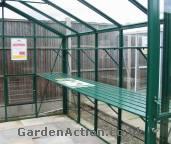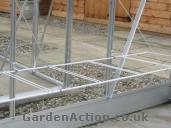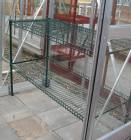Categories
Calendars
Guides
Reviews
Archive
Gallery
Articles
Ask Our Gardening Expert
How to buy the best staging, shelves and
benches for your greenhouse, fully illustrated with pictures.
TOPICS IN SELECTING EQUIPMENT FOR
YOUR GARDEN GREENHOUSE
Staging needs to be strong and capable of supporting the heavy weight
of pots laden with plants and moisture. They also need to be resistant to
water damage and daily wear and tear.
What Type of Greenhouse Staging? The wood should be good quality especially to resist water damage - different
types of cedar are often used to provide a long low-maintenance life.
These types of greenhouse staging are attractive to look at and will provide years of
service. Their disadvantages are that wooden greenhouse staging
is heavy to move,
they
require occasional maintenance and are not completely water-proof. This
last fact may be important if you intend to place capillary matting on
them - aluminium is far more suitable for this purpose. Aluminium staging come in many forms. The picture on the
left shows conventional staging made from aluminium. It is sturdy and
water-proof and the shelves can either be flat or incorporate ready made
trays for growing seedlings. The flat shelves have the advantage that
capillary matting can be placed on them without any damage. If you wish to buy greenhouse staging online, we can
recommend Harrod Horticultural. They manufacture their own greenhouse
staging to very high standards. Click
here for more detailed information. An example of a common attachment method is shown on the right (click to
enlarge) which is common to many greenhouses. The height of the aluminium
shelf can be quickly and easily adjusted. These free-standing aluminium
greenhouse staging and benches come in a variety of colours and finishes. Three more types of aluminium staging, and bench solutions are pictured
below to give you ideas about which is best for your needs. Click on any
picture to enlarge and see it more clearly.
A special purpose greenhouse staging, called a capillary bench, is also
widely available. This bench has a surface with edges raised a couple of
inches (5cm). The surface is lined with capillary matting which goes over
the side of the bench into a vat of water. The capillary matting will
suck up the water and remain damp at all times. Pots placed on the
surface of the capillary matting will then suck up the water and remain
automatically watered. Our recommendation for a supplier of this type of
equipment is Harrod Horticultural. Click here to view their
high quality capillary benching. This is very useful at any time of the year because the potted plants
will remain evenly watered. It is especially useful if you plan to leave
the plants uncared for whilst you go on holidays. Add some liquid
fertiliser to the water vat and the plants will be automatically
fed and watered.
Is Greenhouse Staging Necessary?
Some form of benches, shelves and/or staging is essential for all
sorts of tasks. From potting to simply providing an area to support
growing plants it's a necessity.
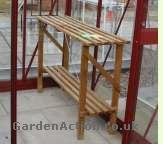 The traditional solution
for greenhouse staging is a free-standing bench of slatted wood.
Sizes vary to a great degree, but a good compromise for a small to medium sized greenhouse
is a bench about 30inch (75cm) high by about 2ft 3in wide. This size of
staging will be a
good working height and will also allow easy access inside the greenhouse. The
slats should be 4in (10cm) wide with 1in (2.5cm) between slats. An
additional lower shelf is a good idea for storing pots, tools and
compost.
The traditional solution
for greenhouse staging is a free-standing bench of slatted wood.
Sizes vary to a great degree, but a good compromise for a small to medium sized greenhouse
is a bench about 30inch (75cm) high by about 2ft 3in wide. This size of
staging will be a
good working height and will also allow easy access inside the greenhouse. The
slats should be 4in (10cm) wide with 1in (2.5cm) between slats. An
additional lower shelf is a good idea for storing pots, tools and
compost.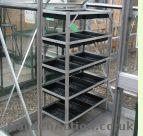 Aluminium
greenhouse staging, shelves and benches are more popular than wood nowadays for
many reasons. They are long lasting, require no maintenance and are light
and portable. They only lack good looks, but even that is a subjective
opinion.
Aluminium
greenhouse staging, shelves and benches are more popular than wood nowadays for
many reasons. They are long lasting, require no maintenance and are light
and portable. They only lack good looks, but even that is a subjective
opinion.
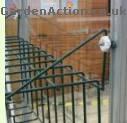 Many
garden greenhouse manufacturers produce staging and shelf equipment
specially made for particular greenhouses. Often these can be attached to
the greenhouse itself with no need for leg supports. This frees up the
are under the shelves for other uses.
Many
garden greenhouse manufacturers produce staging and shelf equipment
specially made for particular greenhouses. Often these can be attached to
the greenhouse itself with no need for leg supports. This frees up the
are under the shelves for other uses.

